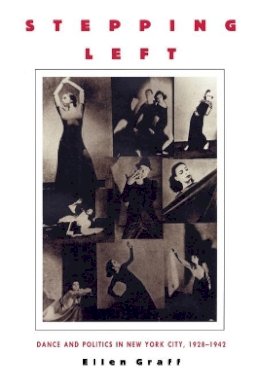
Stock image for illustration purposes only - book cover, edition or condition may vary.
Stepping Left: Dance and Politics in New York City, 1928–1942
Ellen Graff
€ 46.06
FREE Delivery in Ireland
Description for Stepping Left: Dance and Politics in New York City, 1928–1942
Paperback. Unveils the radical roots of modern dance and recalls the excitement and energy of New York City in the 1930s. This book explores the relationship between the modern dance movement and leftist political activism in this period. Num Pages: 264 pages, 58 b&w photographs. BIC Classification: 1KBB; 3JJG; 3JJH; ASD; HBTB; JHM. Category: (P) Professional & Vocational. Dimension: 152 x 229 x 20. Weight in Grams: 481.
Stepping Left simultaneously unveils the radical roots of modern dance and recalls the excitement and energy of New York City in the 1930s. Ellen Graff explores the relationship between the modern dance movement and leftist political activism in this period, describing the moment in American dance history when the revolutionary fervor of "dancing modern" was joined with the revolutionary vision promised by the Soviet Union. This account reveals the major contribution of Communist and left-wing politics to modern dance during its formative years in New York City.
From Communist Party pageants to union hall performances to benefits for the Spanish Civil War, Graff documents the passionate involvement of American dancers in the political and social controversies that raged throughout the Depression era. Dancers formed collectives and experimented with collaborative methods of composition at the same time that they were marching in May Day parades, demonstrating for workers’ rights, and protesting the rise of fascism in Europe. Graff records the explosion of choreographic activity that accompanied this lively period—when modern dance was trying to establish legitimacy and its own audience. Stepping Left restores a missing legacy to the history of American dance, a vibrant moment that was supressed in the McCarthy era and almost lost to memory. Revisiting debates among writers and dancers about the place of political content and ethnicity in new dance forms, Stepping Left is a landmark work of dance history.
From Communist Party pageants to union hall performances to benefits for the Spanish Civil War, Graff documents the passionate involvement of American dancers in the political and social controversies that raged throughout the Depression era. Dancers formed collectives and experimented with collaborative methods of composition at the same time that they were marching in May Day parades, demonstrating for workers’ rights, and protesting the rise of fascism in Europe. Graff records the explosion of choreographic activity that accompanied this lively period—when modern dance was trying to establish legitimacy and its own audience. Stepping Left restores a missing legacy to the history of American dance, a vibrant moment that was supressed in the McCarthy era and almost lost to memory. Revisiting debates among writers and dancers about the place of political content and ethnicity in new dance forms, Stepping Left is a landmark work of dance history.
Product Details
Format
Paperback
Publication date
1997
Publisher
Duke University Press
Number of pages
264
Condition
New
Number of Pages
264
Place of Publication
North Carolina, United States
ISBN
9780822319481
SKU
V9780822319481
Shipping Time
Usually ships in 7 to 11 working days
Ref
99-1
About Ellen Graff
Ellen Graff, a former Martha Graham dancer, is Assistant Professor of Dance at Barnard College, Columbia University.
Reviews for Stepping Left: Dance and Politics in New York City, 1928–1942
“Stepping Left is the first extended study of the origins, development, influence, and legacy of the radical dance movement that emerged in the United States during the 1930s. Quite simply, this book will change how the history of American dance in that decade is written.”— Lynn Garafola, author of Diaghilev’s Ballets Russes “Stepping Left offers a lively synthesis of archival evidence and oral history that vividly recreates an era when dance became ‘a weapon in the revolutionary class struggle,’ to quote the slogan of the Workers Dance League. Graff gracefully integrates biographical information on the dancers involved with accounts of the organizations they founded and descriptions of specific works they created. Her study fills an important gap in the literature on American dance.”—Susan Manning, author of Ecstacy and the Demon: Feminism and Nationalism in the Dances of Mary Wigman
